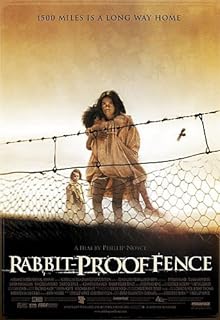電影訊息
末路小狂花--Rabbit-Proof Fence
演員: Everlyn Sampi Tianna Sansbury Laura Monaghan 大衛高皮利 Ningali Lawford Myarn Lawford 黛博拉梅爾曼
漫漫回家路/末路小狂花(台)/防兔篱笆
演員: Everlyn Sampi Tianna Sansbury Laura Monaghan 大衛高皮利 Ningali Lawford Myarn Lawford 黛博拉梅爾曼
電影評論更多影評

2011-04-24 21:22:20
Best Actors Do not Act
Rabbit Proof Fence tells a story about how the three girls, Molly and her sisters escaped from Moore River to walk nearly 2000 mile all the way to home. Molly and her sisters are considered as Stolen Generations that is, the Australian Aboriginal children who were removed from their families by the Australian stage government. The use of the word 「stolen」 implied the immorality and injustice of the robbery performed by the government to take off the identities from the Aboriginal children.
The assimilation conducted by A.O. Neville, the head of the government program, is considered by himsel as empathy to the Aboriginal half-caste children. He feels very proud and responsible for the carryout of the job. However, what he does in the film is cruel and cold-blooded that raises empathy among audience. Neville’s intentional empathy turns out to be cruelty and injustice to the Aborigines he wants to 「save」. The unjustifiable assimilation makes audience feel empathetic about the Aboriginal children.
Not only the story but the advertisement tries to raise the universal empathy to the Aboriginal children. 「What if the government kidnapped your daughter」 pulls the world into the story even before the story begins. The victims of this story are mostly females, including children and their mothers, so naturally people will be easily moved by this kind of set. Also, the story is pulled to step out of the screen and becomes a more documentary style at the end of the film to evoke more empathy from the audience. This approach, similar to what Spielberg uses in Schindler’s List, manages to affect the audience outside the theatres. It provokes further discussion in people’s real life.
The leading roles of Rabbit Proof Fence are children and the camera stays around them for the most of the time. It is a wise idea because such style draws the audience closer to Molly and her sisters. The raw interpretation of the story brings more intensity. The audiences feel so relieved when the protagonists get their way home. Successfully, the director found three aboriginal children without any related experience to acting to carry out the main roles, adding the most important brick to the achievement of the film.
In the documentary on the making of the film, the director says that he is looking for children with special quality so that white Australians would like to say 「they are my kids」. He needs children who keep intact traditional lifestyle and have recently come into contact with the white world; therefore they do not lose their nature. The point, as indicated by the director, is to get them 「not to act」 and to conquer the fear of these little actors doing an adult’s job. The director also manages to have a group of three girls who can work together as real sisters, leading the film more convincing.
Undoubtedly, the wise choice of actors and the effective training enables the film to trigger the real empathy and awareness of the issue from the bottom of the audience’s heart.
Additional Notes:
1. The Stolen Generations is a term used to describe those Australian Aboriginal children who were removed from their families by the Australian stage government. The use of the word 「stolen」 implied the immorality and injustice of the robbery performed by the government to take off the identities from the Aboriginal children.
2. This comparison efficiently translates the storyline of the long film into a simple plot: a wicked witch takes away the children and tries to put a spell of forgetfulness on them, and the children escape a long distance all the way to home. However, I do not think this analogy is really reasonable. First, in classic tales, the border between the good and the bad is very clear, so if the story is interpreted in this way, the government then is asserted as a 「bad」 side, ignoring the fact that the issue of the film is still controversial. 「A spell of forgetfulness」 is a wrong translation of what Mr. Neville wants to do to the Aboriginal children. His intention is to 「save」 the half-caste children from discrimination in the tribe, but unfortunately this leads to the destruction of their family and culture. So the fairy tale interpretation of the issue is too biased to be taken into account.
3. Not only the story but the advertisement tries to raise the universal empathy to the Aboriginal children. 「What if the government kidnapped your daughter」 pulls the world into the story even before the story begins. The victims of this story are mostly females, including children and their mothers, so naturally people will be easily moved by this kind of set.
4. 「The Stolen Generation Narrative」 refers to a true story on children’s view. It is a wise idea because such style draws the audience closer to Molly and her sisters. The raw interpretation of the story brings more intensity. The audience quickly finds himself so relieved when the protagonists get their way home. On the other side, this setting makes the film very biased that does not provide sufficient information on each side using narrative.
5. The story is pulled to step out of the screen and becomes a more documentary style at the end of the film. This approach, similar to what Spielberg uses in Schindler’s List, manages to affect the audience outside the theatres. It provokes further discussion in people’s real life.
6. The assimilation conducted by A.O. Neville is considered by him as empathy to the Aboriginal half-caste children. He himself feels very proud and responsible for the carryout of the job. However, what he does in the film is cruel and cold-blooded that raises empathy among audience. Neville’s intentional empathy turns out to be cruelty and injustice to the Aborigines he wants to 「save」. So the assimilation and empathy are totally different in his case. Additionally, empathy is the feeling that the director wants to raise among the audience, while the unjustifiable assimilation is one of the reasons that audience feel empathetic about the Aboriginal children.
February 26, 2008 舉報
評論

